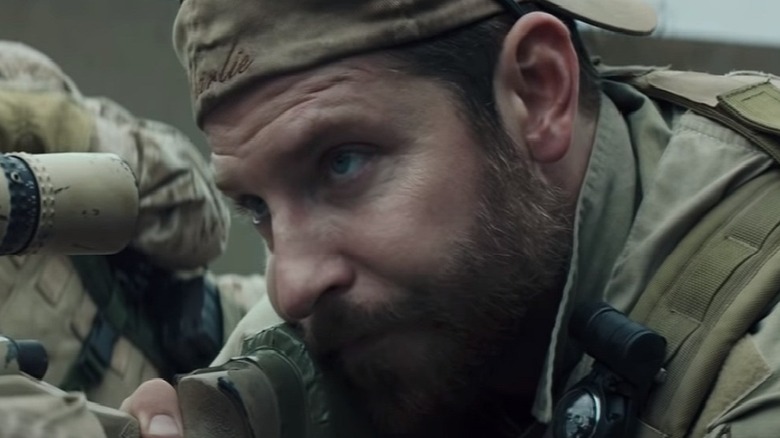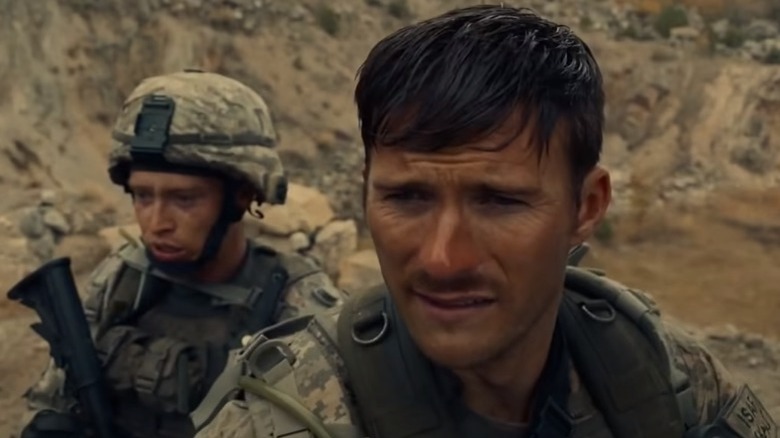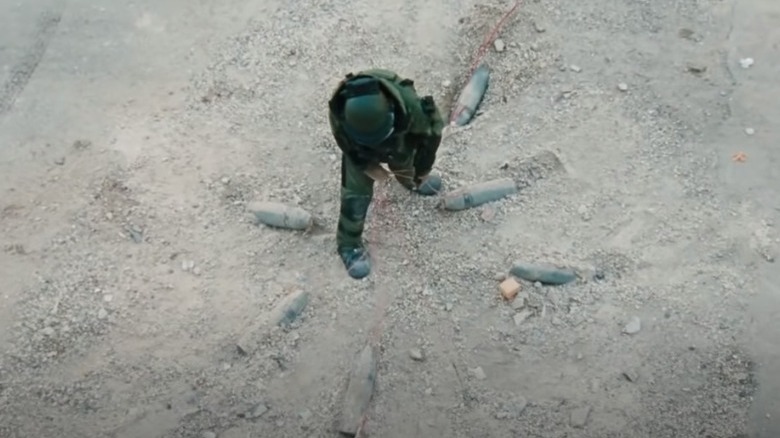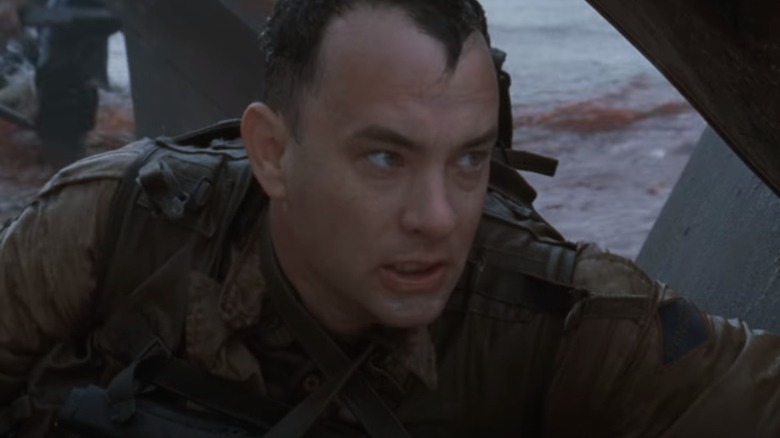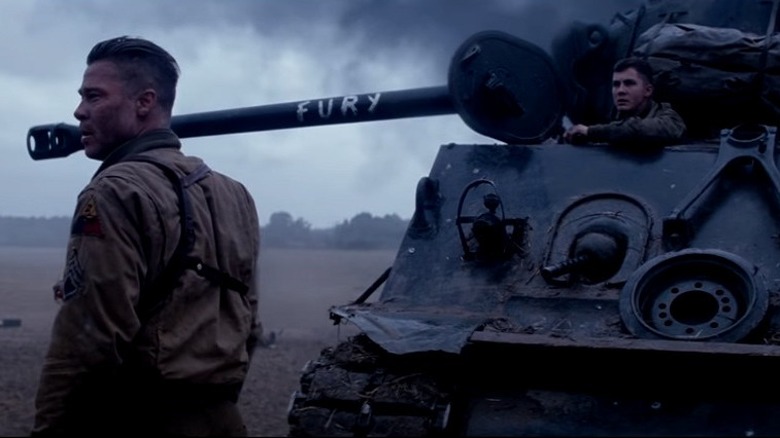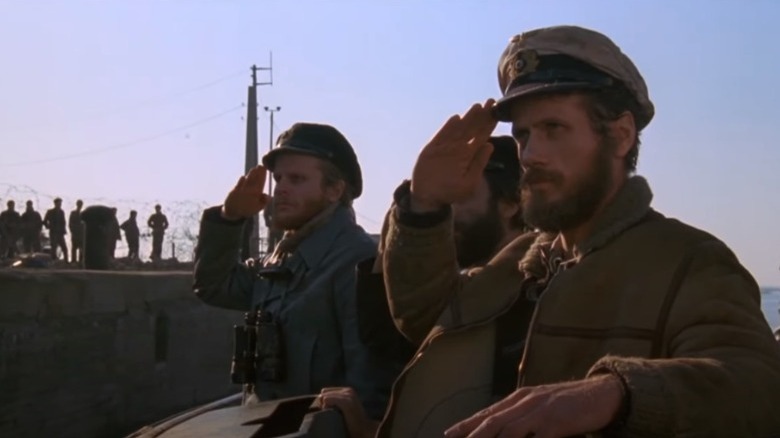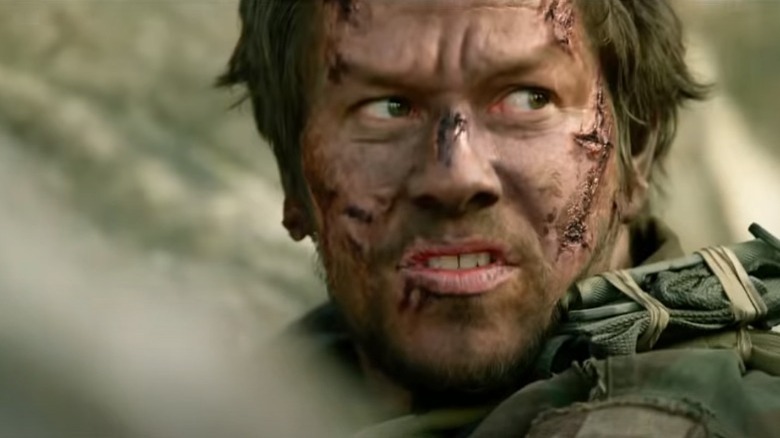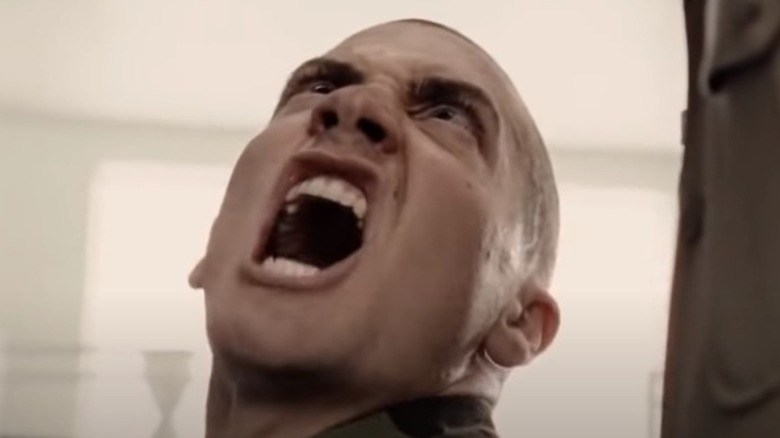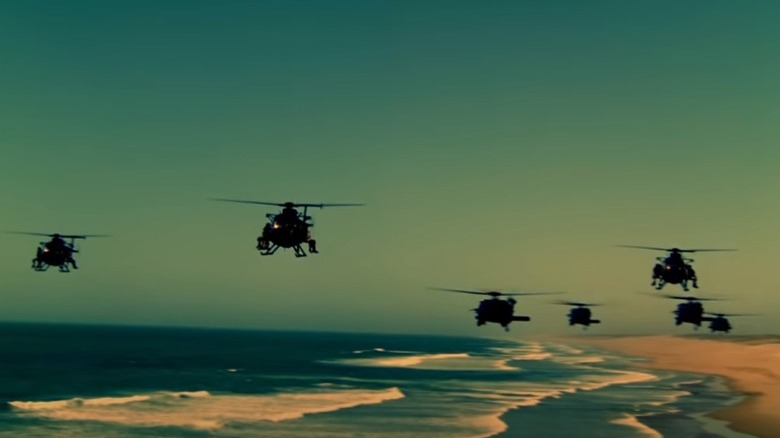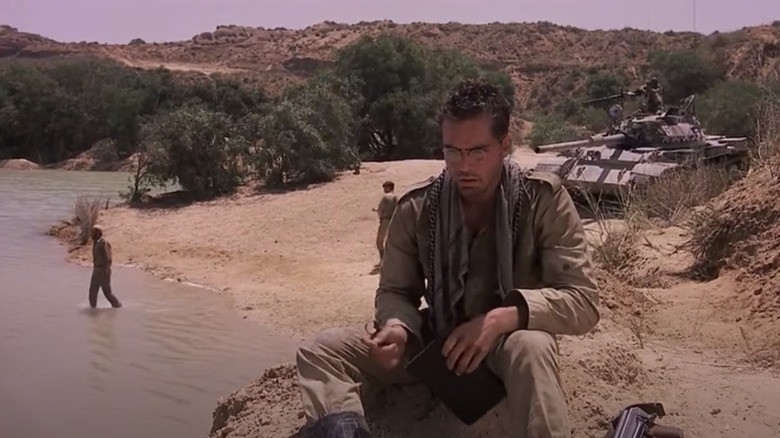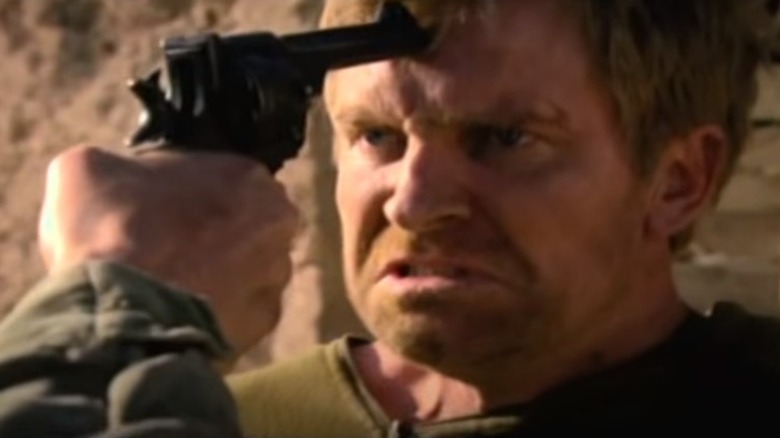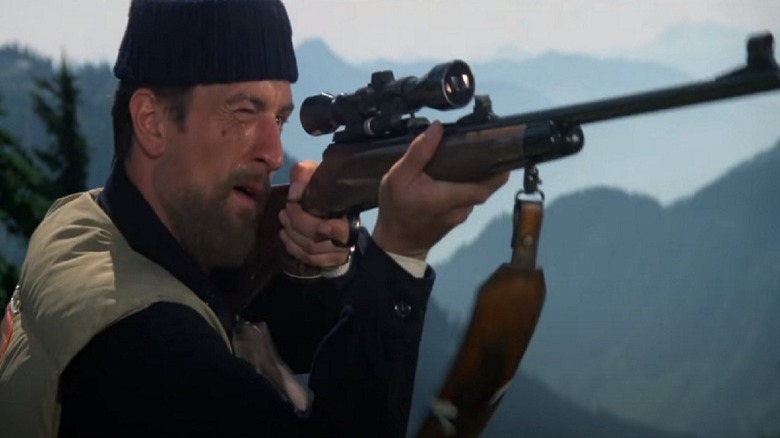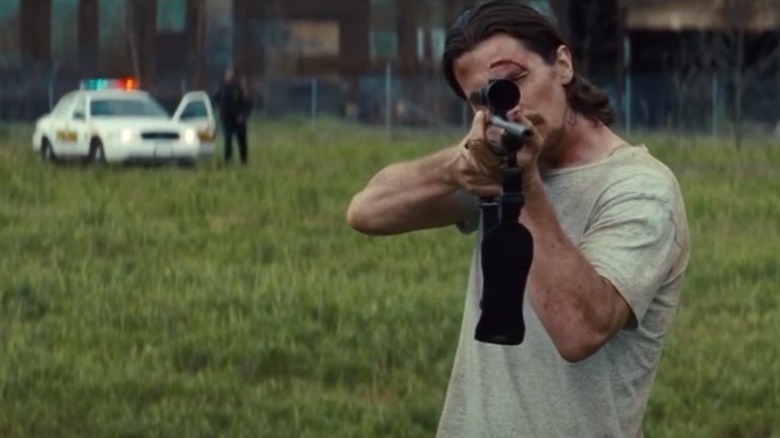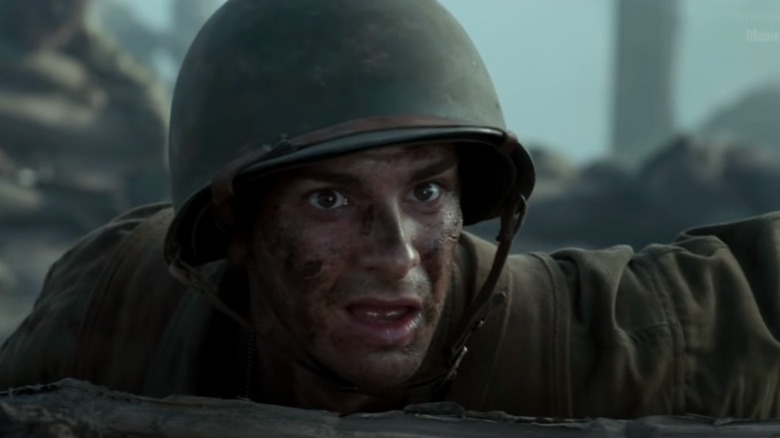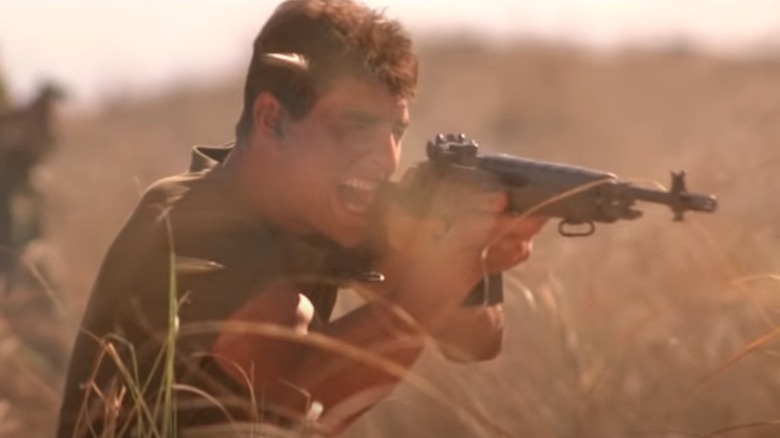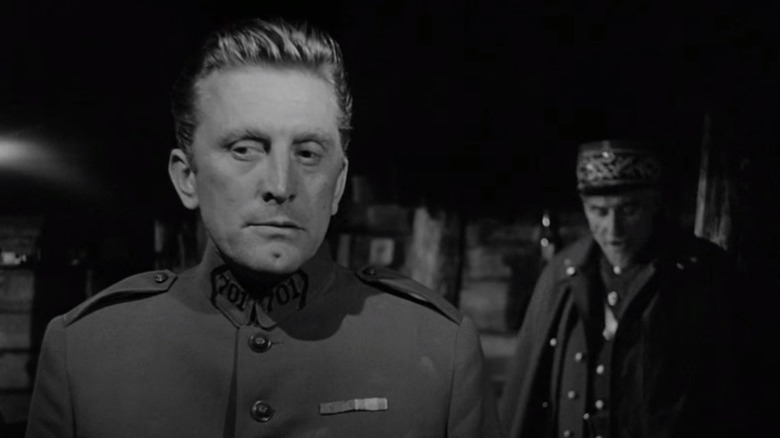15 Movies Like American Sniper That War Drama Fans Need To See
2014's "American Sniper" explores the life of Chris Kyle, a Navy S.E.A.L. sniper known for his extraordinary marksmanship. Directed by Clint Eastwood, the war drama became the most lucrative film of his career. Critics were just as keen to celebrate the film as an evocatively acted, skillfully written masterpiece.
"American Sniper" is also an undoubtedly tense film, defined by action set pieces in which Kyle, played by Bradley Cooper, must read the battleground and make deadly executive decisions. This white-knuckled nature is apparent in the film's trailer, which intersperses a suspenseful scene set in Iraq with moments from Kyle's personal life. What results is a masterful crescendo of anxiety that ranks among the best trailers of recent years. What the trailer does not show is Chris Kyle's strange and shocking death, which the movie presents with tactful pathos.
If you've seen "American Sniper" and are wondering what other war films present a similarly superb blend of tension and drama, we're here to point you in the right direction. These films are a mix of outright war movies, such as the battle-heavy "Lone Survivor" and "Black Hawk Down," and character-driven stories like "Brothers" and "Out of the Furnace." What unites these 15 war dramas is that every "American Sniper" fan needs to see them.
The Outpost
The most recent film on this list, 2020's "The Outpost" is a visceral account of the War in Afghanistan's Battle of Kamdesh. The film is set in Combat Outpost Keating, an army camp built at the bottom of a valley, surrounded by trees, boulders, and mountains up to 12,000 feet high. First Lieutenant Brad Larson, who served at the camp, described it as "like being in a fishbowl or fighting from the bottom of a paper cup."
On October 3, 2009, the vulnerable camp was attacked by some 300 Taliban fighters, killing eight American soldiers and wounding a further 22. Almost one hour of the film's 123-minute running time is used to depict the battle, which produced Medals of Honor for Staff Sergeant Clinton Romesha and Specialist Ty Carter, who are played by Scott Eastwood and Caleb Landry Jones, respectively.
"The Outpost" also depicts the day-to-day life of the camp, especially the power struggles that dogged Keating, which saw numerous leaders during its fraught existence. The performances are uniformly excellent: Each actor is both passionately real and supremely understated. In short, if you're looking for a post-9/11 war film about the reality of soldiering, then "The Outpost" should be at the top of your list.
The Hurt Locker
2008's "The Hurt Locker" was among the first high-profile films to depict the Iraq War, which lasted from March 2003 to December 2011. It was certainly the first post-9/11 war film to sweep the Academy Awards, winning six Oscars, including Best Picture, Best Director, and Best Original Screenplay.
"The Hurt Locker" focuses on William James (Jeremy Renner), a maverick staff sergeant who is assigned to a bomb squad in Baghdad. James has a preternatural flair for bomb disposal, welcoming the immense danger of his job as he marches towards IEDs with only a bomb suit for protection. The fact that his predecessor, Staff Sergeant Matt Thompson (Guy Pearce), was killed by a mobile-operated bomb does not bother James. In fact, it seems to invigorate him. Thompson's death also invigorates the viewer, although for very different reasons. Thick with tension and suspense, the taut scene in question is a signature display of director Kathryn Bigelow's skill and sensibility.
Saving Private Ryan
Anyone who likes war dramas should watch 1998's "Saving Private Ryan." Some criticize it as sentimental, while others, including military historian Antony Beevor, decry it for fulfilling "every war cliché imaginable." However, very few people deny that as a technical display, "Saving Private Ryan" is staggering.
Steven Spielberg's World War II opus reinvented the war movie aesthetic, bringing a harsh, handheld style that emphasizes the chaos and brutality of battle. This is especially true of the opening scene on Omaha Beach, where dozens of troops die as soon as the landing crafts lower their ramps. Relentless MG42 fire tears through the men's bodies, forcing some to throw themselves overboard into the water, where they drown because of their heavy equipment. Until "Saving Private Ryan," few films had ever captured war's merciless waste of human life with such ferocity.
This new vision of conflict comes from Spielberg's direction and cinematographer Janusz Kaminski's bleak, desaturated images. A 2018 article in the Los Angeles Times cites the style of "Saving Private Ryan" as an influence on everything from "Dunkirk" and "Hacksaw Ridge" to "Gladiator" and "all of the high-action superhero films." A war film this influential is required viewing for any cinephile.
Fury
With "Fury," director David Ayer brought the aesthetic of "Saving Private Ryan" to the Allied tank crews of World War II, creating high-impact battle scenes full of crunching bones and clunking machinery. What results is a triumph of sound and vision. The film's extensive sound department captures ricocheting artillery rounds in exquisite detail, while Roman Vasyanov's arresting cinematography is graded with a striking, full-bodied colour palette.
However, much like "Saving Private Ryan", "Fury" falters in certain areas. For example, Brad Pitt's character, Don "Wardaddy" Collier, has impossibly well-kept hair and is introduced as a ninja-like figure when he knocks an enemy off a white stallion and stabs him in the eyes. Such an act of violence is far removed from the average soldier's experience. Moreover, Pitt's performance struggles to eclipse his massive celebrity. Then there's Shia LaBeouf's Boyd "Bible" Swan, a bible-thumping Southerner, and Logan Lerman's Norman Ellison, the stock coward. Both are so familiar, they border on trite.
Despite its formulaic characters and a final act that feels more like a rote action movie than anything else, "Fury" remains a solid war film with enough visceral battle scenes to warrant your attention.
Das Boot
Wolfgang Petersen's "Das Boot" is not only an excellent war movie, it's one of the greatest films ever made. This 1981 feature concerns the Battle of the Atlantic, which was the longest battle of World War II, lasting from September 3, 1939 until May 8, 1945. As the title suggests, "Das Boot" is told from the German perspective, focusing on the submarine crew of U-96 as they patrol the North Atlantic for Allied shipping.
Led by Captain Lehmann-Willenbrock (Jürgen Prochnow), the men of U-96 live cramped, sweaty, and extremely dangerous lives. The German U-boats may have inflicted big losses on the Allies, but they received much pain in return, losing some 28,000 sailors during the war. In the words of the film's foreboding tagline, "Hitler sent out 40,000 men aboard German U-Boats during World War 2. Less than 10,000 returned."
This desperate struggle for survival unfolds over an excruciating two and half hours, full of depth charge attacks from British destroyers that are sure to make your heart race. It truly has to be seen to be believed.
Lone Survivor
Based on the published accounts of Marcus Luttrell, a Navy S.E.A.L. and the last surviving member of a four-man team, 2013's "Lone Survivor" is directly comparable to "American Sniper." The men were on a mission in Afghanistan to locate Taliban leader Ahmad Shah when they were ambushed in a gorge by militants. The elite unit was bombarded with small arms fire, RPGs, and mortar shells, forcing the men to throw themselves down the steep, craggy incline. Director Peter Berg recreates this moment in thunderous detail, capturing the bone-breaking pain endured by Luttrell and his comrades. As The Irish Times evocatively concluded, "It's not a very nice film. But it is a splendidly effective one."
The cast includes Mark Wahlberg, Emile Hirsch, Taylor Kitsch, Ben Foster, Eric Bana, and Dan Bilzerian, whose brief appearance became the subject of a lawsuit. Every single actor is at the top of their game.
Jarhead
2005's "Jarhead" is a subtler affair than "American Sniper." Set during the Gulf War of 1991, Sam Mendes' film depicts elements of war that are rarely considered — specifically, boredom and loneliness. These men have been processed by the military machine to kill other human beings. Yet when they reach their post in the desert, they're confronted with an aimless existence. This sentiment isn't confined to the Gulf War: Even history's worst conflicts have been described in such terms. One New York Times article from 1915 describes World War I as "months of boredom punctuated by moments of terror." Few movies portray this experience, however, let alone so vividly.
Anthony Swofford (Jake Gyllenhaal) is our principal character, joined by comrades such as Staff Sgt. Sykes (Jamie Foxx), Chris Kruger (Lucas Black) and Alan Troy (Peter Sarsgaard). Their most rousing moment is not a skirmish, but a screening of "Apocalypse Now," especially the iconic "Ride of the Valkyries" scene. This is in keeping with French philosopher Jean Baudrillard's famous declaration that "the Gulf War did not take place": The conflict, though deadly, was a media spectacle before anything else, as he saw it. "Jarhead" presents this point of view beautifully thanks to Roger Deakins, the revered cinematographer. Especially striking are the oil field scenes, which evoke the haunting photography of Steve McCurry.
Black Hawk Down
2001's "Black Hawk Down" is another war drama that takes stylistic cues from "Saving Private Ryan," which was released three years prior. Directed by Ridley Scott, this film depicts the 1993 Battle of Mogadishu, an 18-hour clash that resulted in the deaths of 18 U.S. troops and hundreds of Somali fighters and civilians.
Josh Hartnett is ostensibly the lead actor of the film, yet "Black Hawk Down" is not a character-driven movie — and it isn't a political one, either. Instead, it is a yard-by-yard account of a ferocious urban battle: 144 grueling minutes of gunfire, death, and explosions. Variety's review put it well when it called the movie "strikingly realized but none too pleasurable to sit through." Other critics generally agreed, hailing the film as intense above all else. If you're looking to take in a visceral account of warfare, "Black Hawk Down" may be the film for you.
The Beast
Hollywood has paid little attention to the Soviet invasion of Afghanistan, which lasted from 1979 to 1989. One rare exception is 1988's "The Beast," an underrated war drama from director Kevin Reynolds, who would go on to helm "Robin Hood: Prince of Thieves" and "Waterworld." Based on the stage play "Nanawatai" by William Mastrosimone, "The Beast" follows a Russian tank crew as they battle the Mujahideen deep in the rugged Afghan countryside. However, much of the danger comes from Daskal (George Dzundza), the crew's brutish commander. This leads to deadly in-fighting, reminiscent of 1987's "Platoon."
Despite being a solid war drama, "The Beast" quickly faded into obscurity after performing poorly at the box office. Warm appraisals of the film have arrived since then, but it remains a criminally underrated tale of battle. Cinephiles of all stripes would do well to track "The Beast" down and give it its due.
Brothers
In 2009, "Brothers," starring Jake Gyllenhaal, Natalie Portman, and Tobey Maguire was released to mixed reviews and mediocre box office numbers. A melodrama, it follows a wife and mother who believes her husband has died in Afghanistan, only for him to return after she begins a romantic relationship with his brother. Writing for The Atlantic, film critic and former New York City mayor Ed Koch appraised "Brothers" in refreshingly simple terms: "Although 'Brothers' is not a first-rate film, it informs us about the after-effects of war and is worth seeing while we wait for better ones to come along."
Koch was apparently unaware that there already was a better film — the Danish feature released five years earlier that 2009's "Brothers" is based on. Directed by Susanne Bier, 2004's "Brothers" avoids the melodrama of its American counterpart, telling a very similar story in a far more skillful way. Unlike several films on this list, "Brothers" is very much a character-driven war drama, with comparatively few scenes occurring in combat zones. Here, that zone is Afghanistan.
The Deer Hunter
A landmark film of the New Hollywood period, 1978's "The Deer Hunter" is a defining account of men, community, and warfare. It follows a small group of mill workers including Michael (Robert De Niro), Nick (Christopher Walken), and Steven (John Savage) as they're drafted into the Vietnam War. The film's three-hour runtime explores their lives before, during, and after the conflict.
The men's central trauma occurs when they're caught by Viet Cong revolutionaries who force them to play Russian roulette. Some criticize the scene as biased, while others decry it as an utter falsehood. As Pulitzer Prize-winning reporter Peter Arnett wrote in The Los Angeles Times, "There was not a single recorded case of Russian roulette ... The central metaphor of the movie is simply a bloody lie."
According to director Michael Cimino, however, "Russian roulette is a metaphor for what America was doing with its young people, sending them to a war in a foreign place, when there was no justification for it." Critics like Roger Ebert agreed: He hailed the scene as "the organizing symbol of the film: Anything you can believe about the game, about its deliberately random violence, about how it touches the sanity of men forced to play it, will apply to the war as a whole." Whatever one thinks of the Russian roulette scene, it's only one part of an epic film full of tremendous performances, sweeping photography, and acute dramatic intensity.
Out of the Furnace
The Iraq War looms over this 2013 Rust Belt noir, which owes a large debt to "The Deer Hunter." Like its forebear, "Out of the Furnace" has one heck of a cast, including Christian Bale, Casey Affleck, Woody Harrelson, Willem Dafoe, and Forest Whitaker. The drama focuses on brothers Russell (Christian Bale), a mill worker, and Rodney (Casey Affleck), an Iraq veteran. After he returns from duty, Rodney runs up debt with John (Willem Dafoe), a scuzzy yet accommodating loan shark. Rodney pays him back by fighting in bare-knuckle boxing contests held in old factories and warehouses, risking his health every time. Money becomes so tight that Rodney persuades John to send him to a big fight hosted by Harlan DeGroat, a hateful criminal who Woody Harrelson plays with genuine spite and evil.
Again, the DNA of "The Deer Hunter" is all over this film: Affleck's character is Christopher Walken's character, Bale's character is Robert De Niro's character, and bare knuckle boxing is Russian roulette. But when the performances are this good and the aesthetic is this compellingly harsh, such familiarities are not a problem. "Out of the Furnace" is an absorbing exercise in grimy drama.
Hacksaw Ridge
2016's "Hacksaw Ridge" tells the remarkable story of Desmond Doss (Andrew Garfield), a conscientious objector who refused to carry a gun, yet saved 75 men during the Battle of Okinawa. Director Mel Gibson has become known for focusing on the potential violence of an era over the actual facts, a trait apparent in "Braveheart," "Apocalypto," and "The Passion of the Christ." This is also somewhat true of "Hacksaw Ridge," which features some of the goriest battle scenes since "Saving Private Ryan." Writing for The New Yorker, critic Richard Brody described the "mutilations and agonies, sprays and spurts of blood and cascades of human meat" that fill the screen as Doss runs into the line of fire, saving life after life.
However, while Gibson displays his trademark instinct for violence in this film, he does not indulge his tendency for historical mistruth. History vs. Hollywood found that "Hacksaw Ridge" stays true to the record in most cases, with Gibson even omitting a scene of Doss getting shot by a sniper because he thought the audience wouldn't believe it.
Born on the Fourth of July
1989's "Born on the Fourth of July" is the second film in director Oliver Stone's Vietnam trilogy, with the first being 1986's "Platoon" and the third 1993's "Heaven and Earth." It's a morality tale about Ron Kovic, a zealous young marine who was paralyzed from the waist down during the Vietnam War. Kovic was the child of a patriotic military family, who took President John F. Kennedy's immortal words — "Ask not what your country can do for you, but what you can do for your country " — to heart. However, Kovic's disastrous tour of Vietnam completely flipped this mindset, turning him into a prominent activist in the American anti-war movement. Jane Fonda once recalled him saying, "'I may have lost my body, but I've gained my mind."
Tom Cruise is perfectly cast as Kovic, lending his all-American charm to a young man whose idealism slowly, brutally crumbles out from under him. Cruise's performance earned him his first Oscar nomination for Best Actor, which he lost to Daniel Day Lewis for his remarkable turn in "My Left Foot."
Paths of Glory
Stanley Kubrick's classic 1957 war drama is considerably less violent than other films on this list. Yet it retains its gut-punch power more than 60 years after its release. Based on the novel by Humphrey Cobb, "Paths of Glory" stars Kirk Douglas as a French colonel who battles his superiors to prevent the execution of his troops, who have been accused of cowardice in the midst of World War I.
Even the most cursory glance at viewers' and critics' responses to "Paths of Glory" reveals praise of the highest sort. The Radio Times refers to Kirk Douglas' performance as "outstanding," while Total Film describes depictions of trench warfare as "frighteningly vivid." The Guardian makes the biggest claim, celebrating the drama as "arguably the best film about the First World War, [which] still has a reasonable claim to being Stanley Kubrick's best film." Perhaps the greatest testament to the film's power, however, is the fact that France did not show it until 1975, owing to its negative depiction of the French army's generalship.
